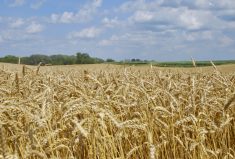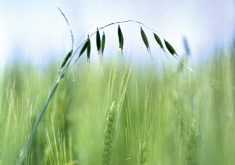Linda Hall has a soft spot for the humble oat, mainly because she doesn’t think it’s really all that humble.
“Milling oats are a high-value crop,” Hall says. “We’re seeing companies like Richardson buying up oat milling capacity, so the markets are there if we can grow the right kind of oat.”
It all depends on that small word “if.”
A professor with the University of Alberta’s agricultural, life and environmental sciences department, Hall has just wrapped up a three-year study that took a hard look at oat production in central Alberta. She and her team wanted to find out which oat cultivars and production methods would help growers produce the kind of high-value oat crops millers are so clearly looking for.
Read Also

Producers aren’t panicking over tariffs and trade threats
The influence of tariff and trade uncertainity on farm business decisions.
Why central Alberta? Because it’s here that oat production is experiencing something of a Catch-22. Oats grown here are typically destined for the lower-value feed and pony oat markets, yet Hall says the region has all the ingredients for successful, high-value milling oat production. “It has black, rich soil, lots of rainfall, cooler conditions — we’re sitting in a great area for oats,” she says.
So while high-quality, high-value milling oat production is possible here, producers are focused elsewhere.
“If you’re a farmer, you’re thinking ‘What am I going to make money with’ and right now, that’s not oat,” says Hall. “And it’s a double whammy because part of why oats don’t pay their own way is that they’re not treated as well as other crops.” Often seeded late and lacking good in-crop care, is it any wonder oats fail to perform?
Finding out what’s possible
The focus of Hall’s study, which was funded in part by WGRF, was to figure out how to optimize oat yield, quality and standability so that farmers could up their game and sell into the milling oat market. The team looked at the effect of oat cultivars and nitrogen fertilization on yield, test weight, lodging and beta-glucan content. They also investigated the use of plant growth regulators (PGRs) to reduce lodging — a common problem with oats and one that can reduce yield and quality.
For the first part of the study — looking at cultivars and their response to nitrogen — experiments were conducted in Barrhead and St. Albert using AC Morgan, CDC Morrison, CDC Stride, CDC Norseman and CDC Sea Biscuit. In all plots, urea was side-banded five cm below the seed. Then, based on soil analysis, ammonium was placed with the seed. Researchers measured plant height at maturity, assessed lodging just prior to harvest, and assessed yield.
To look at how different rates of N and the use of a PGR would affect yield and lodging, experiments were done at the two Alberta sites plus one other at Indian Head, Sask. Here, CDC Stride was seeded into canola stubble in randomized plots, N was applied at four different rates (5, 50, 100 and 150 kg/ha), and trinexapac-ethyl growth regulator applied in four concentrations (0, 70, 100 and 130 grams of active ingredient per hectare).
The results were encouraging, but not all were definitive. For instance, while researchers found that an application of N would make all cultivars grow a bit taller and improve yield, increasing the rate past a certain point didn’t show a lot of benefit. Indeed, higher rates of N resulted in lower grain quality and increased lodging problems.
“We found that 100 kilograms of nitrogen per hectare is optimum for oat cultivars in general,” says Hall, noting that most recommendations are for 80 kg/ha. It’s important because you want the N to boost yield, but not so much that plants get top-heavy and lodge. “This is a nice simple answer to achieve maximum yield under good growing conditions.”
In terms of cultivar performance, Hall was pleasantly surprised by an old standby. “AC Morgan is an amazing variety,” she says. “I expected the newer varieties to yield better, but Morgan really stands up.” The trouble is that the beta-glucan level of AC Morgan is typically lower, so the challenge is to find ways to boost that in this high-yielding variety.
CDC Norseman, which has higher beta glucan, showed potential for increased yields in the study, and CDC Stride seemed to be the first one to fall down.
PGR surprises
The PGR work was also illuminating. One of the surprises of the study for Hall was the efficacy of trinexapac to reduce plant height, and therefore lodging, in specific growing conditions. In high-moisture years, she explains, plants grow taller, produce more seed and have an increased potential to lodge. The PGR turned out to be a very effective foil in these situations, sometimes reducing plant height by 10 to 12 inches.
“PGRs have a fit, but it’s not everywhere and not every year,” says Hall. “Growers can have this in their back pocket — see how their year is going before having to make a decision. Mid-June is application time for PGRs, so by then, you know how much rain you’ve had, how the crop is growing. Then if it looks like you’ll need it, you’ve got it.”
Oat is sort of the forgotten child of research funding, which is one reason Hall is so pleased that farmers themselves, through WGRF, chose to fund this study. “I’m so grateful that farmers have put their trust in us to do this work, and I feel totally responsible because they work hard for their money,” she says.
“This study is the beginning of more studies,” says Hall. “We’re taking what we’ve learned here into new research.”
For now, though, she has one clear message for central Alberta farmers. “Oat has potential in your rotation. Stay tuned, because we’re going to try and show you the best way to reach that potential.”
Hall’s study into optimizing oat production was funded by:
- Western Grains Research Foundation (WGRF)
- Alberta Crop Industry Development Fund (ACIDF)
- Prairie Oat Growers’ Association
- Syngenta Canada















